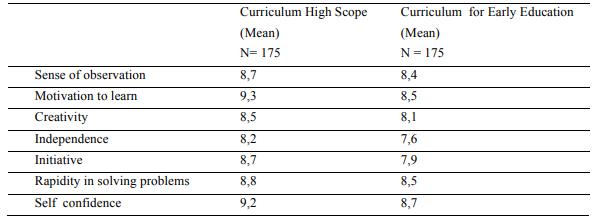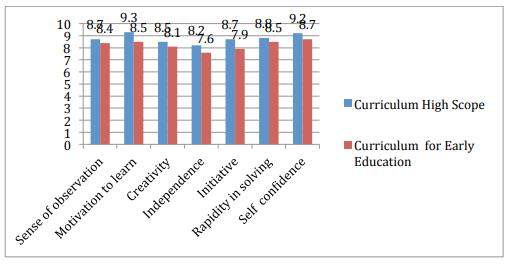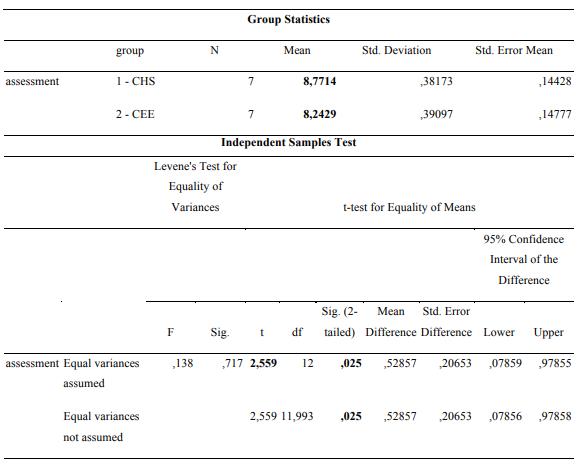Abstract
In my paper I would like to underline the newest methods used in preschool education. Nowadays High Scope revolutionized early childhood education with a new approach to teaching and learning. For infanttoddler teachers, High Scope provides a comprehensive curriculum that addresses all areas of children development. Child based research discover that the High Scope Curriculum uses a carefully designed process, a process that determined children to actively participate in learning. The main objectives of preschool education emphasize the development of the fundamental skills that help and determine success in adult life. Being the most dynamic period for the development of child personality, kindergarten takes the leading role in education. Researchers have discovered, that the High Scope Preschool Curriculum not only helps young children excel in cognitive learning but also promotes independence, curiosity, decision-making, cooperation, persistence, creativity, and problem solving. Over time, man has been concerned with child education. Thus, specialists have attempted to study and identify the most viable ways of intervention in children education so that they would develop according to their innate abilities.
Keywords: High scope; education; early agemotivation; stimulation; curriculum
1. Introduction
Over time, man has been concerned with child education. Thus, specialists have attempted to study
and identify the most viable ways of intervention in children education so that they would develop
according to their innate abilities. The child, acts upon the objects s/he makes contact with and is actively
involved in his/her epistemological knowledge when s/he listens, talks, feels, sees, handles, builds and
uses those objects. Active learning is regarded by scholars as an active process of actual involvement in
one`s own training. The involvement is both mental and physical. Considering that the pre-schoolers` age
is placed in psychological terms at an operational level, or more specifically the pre-operational stage, as
Piaget refers to it, children need to learn based on a rich intuitional material. Neuro-psychological studies
reveal that the educational environment as well as the way its development is stimulated are important in
the development of human brain`s cognitive abilities (Ansari, D., 2005). The child needs to interact
directly with the environment and the objects in order to activate the cognitive abilities. The child builds
his/her life experience by interacting and directly exploring the world, by actively handling objects,
interacting with adults and peers from his/her immediate environment.
Morisson, in his book (Morisson, G., 2007) asks some pertinent questions:
How can we achieve a high quality education?
What are the basic features of such an educational programme?
What would be the main directions of a proper early education curriculum?
How can such an educational programme be successfully implemented?
First of all, we have to understand that pre-schoolers have the ability of learning by using their
basic and most pleasant activity, which folds to their age characteristics. Through play, preschool children
learn easily, the effort they make is pleasant and the actual activity is not regarded as obligation (Smith,
P.K., Pellegrini, A., 2013). Below, there are some scholars` opinions about play as learning activity or as it is sometimes referred to in the literature
Froebel (Lindqvist & Lofdal, 2001) - through play children learning by being active;
Montessori - (Bergen & Mauer, 2000; Saracho, 2003) - children develop their emotional perspective through play;
Wood, E. (2013) – children socialize through play;
Dunn (2007) - children develop interpersonal relations through play;
Rogers, S. (2011) – children develop language through play
Gilmore et al. (2007) – children develop their cognitive abilities through play.
Besides play, the educational environment plays an important part in child education (Johansson,
& Pramling, S., 2006). Loris Malaguzzi in his constructivist model called
child centred learning approach and puts particular emphasis on the educational environment, considered
the third teacher. This educational environment includes the entire community as active participant,
involved and dedicated to child education in the best and most appropriate conditions.
2. High Scope Education Approach
The main objective of this approach in preschool education is represented by “active participatory
learning,” High Scope Education takes into account the child`s way of being, his/her real development
abilities and advances a Curriculum focused on the development of child`s personality on all levels. This
programme focuses on child development progressively from a very early age taking into consideration a
child`s learning abilities at early ages. (Schweinhart, L., Montie, J., Xiang, Z., Barnett, W., Belfield, C., &
Nores, M., 2005). The teacher interferes with very carefully planned activities which aim child
development according to a child`s own pace and possibilities. It is believed that a child`s active
involvement in learning leads to motivation and knowledge stimulation as well as to plenary child
development. This very aspect is stressed out by the Curriculum based on high scope education by emphasizing the following aspects:
planning of daily activities according to the children`s age;
stimulating learning by selecting learning activities which arise their curiosity;
using educationally suitable teaching materials;
motivating children for a full and active engagement in learning activities.
Learning within high scope programmes occurs under close teacher guidance, children and
teachers are partners in learning. Learning takes place in an educational environment which has been
adapted to preschool age. The main learning activity is play. Children have at hand different and
attractive materials that arise their interest towards knowledge and motivate them to discover, ask
questions and get actively involved in learning. Teachers support the child`s evolution step by step,
interfere when necessary and use the most appropriate methods which would determine the child to move
on to a superior level of knowledge according to his/her own pace. .
Linda Dunlop, in 2014, in her book
Help children develop the ability to make choices;
Help children develop self-discipline by carrying out plans;
Develop children's ability to cooperate with others;
Increase children's knowledge about objects and skills;
Increase children's ability to express thoughts, ideas, and feelings;
Help children better understand verbal and nonverbal communication;
Develop children's ability to apply reasoning skills to a variety of situations;
Further develop children's creativity, initiative, and openness to learning. (Dunlop, L., 2014).
High scope education focuses only on the child`s interest and takes into account his/her abilities
and skills within the learning programme. The Curriculum focuses on five main approach areas in child
development: approaches to learning; language, literacy, &communication; social and emotional
development; physical development, health, and well-being; and arts and sciences. (High Scope Educational Research Foundation, 2009).The main objectives of High scope approach in education are:
active learning;
arranging the educational environment;
daily schedule;
assessment;
curriculum.
Daily activities which form the basis for the implementation of High Scope programme are
designed according to children`s age characteristics and individual features as well as the child`s
independence in actions. The programme is elaborated according to the child`s level of understanding.
Pre-schoolers are all equal within the educational programme and are capable of acting according to their
own interests, taking decisions and acting confidently and responsibly. To reach their goals, educators
talk to the pre-schoolers about future activities, the topics and subjects they would like to approach. This
attitude favours an responsible and stimulating working climate for all children. The educators` role is the
generate experiences which are proper for the children`s concerns, which enrich their life experience and
develop their abilities. While pre-schoolers perform various activities, the educators observe the
relationships that develop between them, the ways of interaction. While pre-schoolers perform various
activities, teachers observe the relationships that develop between them, the ways of interaction, the
problem solving abilities and interfere only to encourage the children, to support their activity and help
them when necessary. Morrison underlines in
offers: a method for implementing a constructivist-based program that has its roots in Dewey’s
philosophy and Piagetian cognitive theory. (Morrison, G., 2011).
3. Methodology
Our study was conducted throughout the school year 2015-2016, in 7 kindergartens in Arad with
more parallel groups of the same age. Initial testing revealed similarities between groups in terms of
psycho-physical development. The experimental groups were numbered with A from 1 to 7. These groups
worked with the High Scope Education Programme while the parallel groups conducted their usual
activity. The hypothesis was that if the High Scope Educational programme is introduced, then the pre-
schoolers will be better prepared for school. This aspect is noticeable in their oral and written fluency
abilities, in their inter-human socializing abilities, in the rapidity of problem solving and in the way they
deal with emotions.


To test out our hypothesis, we used the independent t test coefficient. We expected to find out
significant differences between the Curriculum High Scope group - CHS (N= 175) and Curriculum for
Early Education group - CEE (N = 175) related to the mean evaluations of the 7 dimensions tested: sense
of observation, motivation to learn, creativity, independence, initiative, rapidity in solving problems and
self-confidence.

As presented in Table 2, when analyzing the differences between CHS and CEE assessments, we
obtained a coefficient t= 2,559 significant at a p < 0, 05 result that confirms our hypothesis. The mean of
CHS assessment m=8,77 is significantly superior to the mean of CEE assessment m=8,24, fact that
clearly proves that CHS group has developed better competences: sense of observation, motivation to
learn, creativity, independence, initiative, rapidity in solving problems and self-confidence, than CEE
group. This curriculum aims to promote active learning by providing many opportunities for children to
initiate their own activities and take responsibility for completing them. Active participatory learning
suggests that children learn best through hands-on experiences with context, situations and information.
In the High-Scope approach the control of current situations are shared between children and adults,
compared to traditional approach, and adult’s role is to support and guide children in developing
adventures and experiences that integrate learning by doing.
4. Conclusions
The High Scope Education programme is the best way to improve the development of children’s
personality: this approach stimulates the participation of all children in the daily activities with pleasure,
interest and the most important thing is their high motivation. While children participate in the teaching
activities they are challanged to initiate, to discover, to experience and learn about different people,
objects, ideas, events, as well as learn in a proper manner. The High Scope Education programme
promotes a curriculum particularly adapted to children and integrates all aspects of their development.
This aproach enhanges the children evoluation in the foundation of academic growth as well as in their
physical and psychical dimension. The High Scope programme is adapted to each individual and has as
main objective: a complex system of teaching practices, defined curriculum content areas for each topic
and age group, assessment tools, and a training model. Thus, children who undergo this learning
programme improve their preparation for school by creating, experimenting, problem-solving, and
solving conflicts. The principle of High Scope approach is oriented to teach and learn, to educate children
through hands-on experiences with materials, events, ideas and people.
High Scope Education’s principle Plan-do-review, developed to help play become meaningful
implies many different ways of putting it into practice, thus adapting any other learning techinque to this
approach is not such a difficult task. In short-term, High Scope teaching and constructivist program were
about equally effective in the cognitive domain, but long term, the additional benefits were more obvious:
better self-regulation, a good attitude towards work, motivation and a positive social adjustment and
behavior, which had superior social outcomes (reduced delinquency and increasing economic
independence) in early stages of adulthood compared to other approaches. These social outcomes can be
best highlighted in a subsequent period of the program.
References
- Ansari, D. (2005). Paving the way towards meaningful interactions between neuroscience and education.
- Developmental Science, Volume 8, Issue 6 November 2005, Pages 466–467.
- Blakemore S.-J. & Frith U., (2005), The learning brain: Lessons for education, Developmental Science
- 8:6 (2005), pp 459– 471, Blackwell Publishing Ltd., 9600 Garsington Road, Oxford OX4
- Dunlop L., High Scope: One Program Model, Excerpt from An Introduction to Early Childhood Special
- Education, by L.L. Dunlap, 1997 edition, p. 20-21. Available at:
- http://www.education.com/pdf/high-scope-one-program-model. Accessed [20.082016].
- High Scope Educational Research Foundation. (2009). Preschool Curriculum. Retrieved December 10,
- 2009, Available at: http://secure.highscope.org/Content.asp?ContentId=63 Accessed [20.07.2016].
- Morisson =G. =(2011). =High =Scope: =A =Constructivist =Approach
- http://www.education.com/reference/article/high-scope-constructivist-approach/ =Accessed
- [12.06.2016].
- Morisson George, (2007). Early Childhood Education Today,
- http://catalogue.pearsoned.co.uk/preface/0132286211.pdf Accessed [12.06.2016].
- Rogers, S. (2011). Rethinking play and pedagogy in early childhood education: concepts, contexts and
- cultures. Albingdon, England; New York: Routledge.
- Schweinhart, L., Montie, J., Xiang, Z., Barnett, W., Belfield, C. & Nores, M. (2005). Lifetime effects: The High/Scope Perry Preschool study through age 40. Ypsilanti: High/Scope Press.
- Smith, P. K., & Pellegrini, A. (2013). Learning through play. Rev ed. Smith PK, topic ed. In: Tremblay RE, Boivin M, Peters R. De V., eds. Encyclopedia on Early Childhood Development [online].
- Montreal, Quebec: Centre of Excellence for Early Childhood Development and Strategic Knowledge Cluster on Early Child Development; 2013:1-6. Available at: http://www.childencyclopedia.com/documents/Smith-PellegriniANGxp2.pdf. Accessed [20.08.2016].
- Thomas, L., Warren, E., & De Vries, E. (2011). Play-based learning and intentional teaching in early childhood contexts. Australasian Journal of Early Childhood, 36(4), 69–75.
- Wood, E. (2013). Play, learning and the early childhood curriculum (3rd ed.). London: Sage Publications.
Copyright information

This work is licensed under a Creative Commons Attribution-NonCommercial-NoDerivatives 4.0 International License.
About this article
Publication Date
25 May 2017
Article Doi
eBook ISBN
978-1-80296-022-8
Publisher
Future Academy
Volume
23
Print ISBN (optional)
-
Edition Number
1st Edition
Pages
1-2032
Subjects
Educational strategies, educational policy, organization of education, management of education, teacher, teacher training
Cite this article as:
Kelemen, G. (2017). High Scope Approach to Preschool. In E. Soare, & C. Langa (Eds.), Education Facing Contemporary World Issues, vol 23. European Proceedings of Social and Behavioural Sciences (pp. 349-355). Future Academy. https://doi.org/10.15405/epsbs.2017.05.02.43

